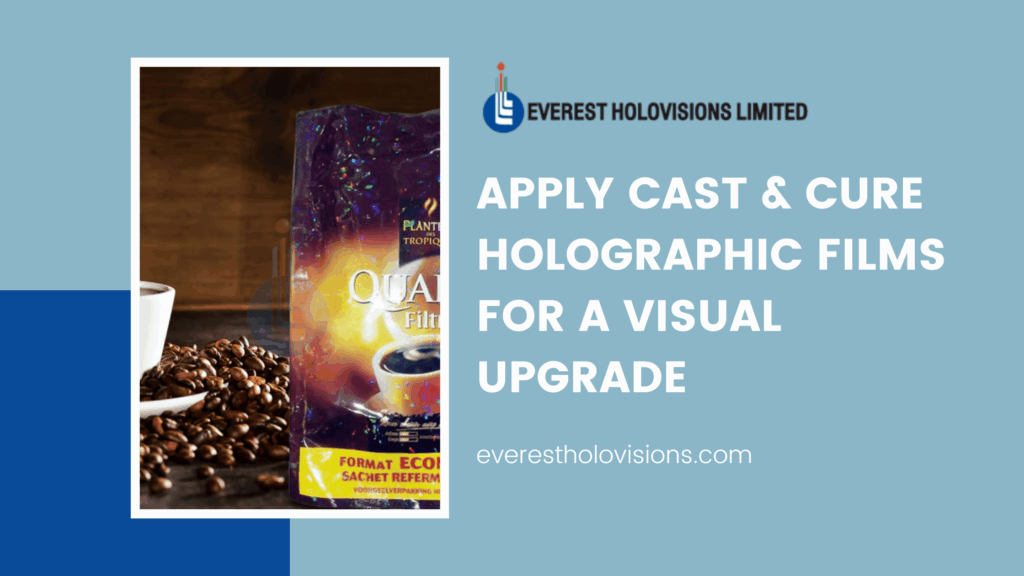The way a product is packaged greatly affects a consumer’s view of it. A poor design on the packaging may cause sales to drop and prevent the brand from taking advantage of opportunities. When many similar products are shown together in stores, it’s important for products to catch the customer’s eye. Cast & Cure holographic films are known to make packaging better by enhancing its design, making it sturdier, and boosting its efficiency.
Understanding the Cast & Cure Process
Cast & Cure, also known as film casting, is a method used to add holographic, gloss, matte, or textured effects to various printed items. It mixes UV or EB varnishes with embossed films that can be reused to produce light-diffracting effects and finishes on the packaging without adding anything to it.
The first step is to coat the printed surface with a wet UV- or EB-curable coating. A film with tiny patterns is laminated to the wet coating. As the coating is exposed to UV or electron beam light, the film leaves its pattern on the surface. The film is taken out when it is cured and then rewound for reuse. The outcome is that a neat, precise image remains on the material.
How to Enhance the Look of a Film Without Increasing the Difficulty of Production
One benefit of these films is that they can enhance the appearance of packages without affecting their main structure or requiring significant changes to current production lines. This process is suitable for use with most UV and cold foil presses and is effective on offset, flexographic, and gravure printers. Therefore, printers and converters can introduce superior finishes for less money.
Through Cast & Cure, the holographic effect changes the way light reflects and the appearance of the product as you move around it, which helps capture consumers’ attention. Because the effect is clear, it does not change the main designs, texts, or logos of a brand. Brands can use it in certain regions to draw attention to logos, graphics, or borders or apply it everywhere to make the design more interesting.
Improving Print Quality by Making It Durable
These films help improve the overall finish of a piece. They add to the longevity of what is printed on the surface. UV or EB coating is used during the process to help protect the material from scratches, water, and wear. It is particularly helpful for goods that are handled or transported in places where their packaging could rub against something.
The embossing process does not damage the structure of the material used in the film. As a result, the process can be used for both stiff and flexible materials, including paperboard, plastic films, tubes, and cartons. Regardless of whether this film is used for makeup, electronics, food, or drugs, it gives products a professional finish that stays the same as the product matures.
Reusing Films Is an Eco-Friendly Method for Film Production
Depending on how the film is used and the equipment involved, a single holographic film can be reused. Since the packaging doesn’t receive any film, it stays unharmed and is easily rewound after every use. As a result, there is much less waste compared to the older methods of making holographic foils.
Moreover, this film does not require metal layers or extra adhesives, so the end product can still be recycled. UV and EB varnishes are used to avoid VOCs, helping the company operate in an eco-conscious way.
This film gives companies a chance to protect the environment while maintaining their design principles. It helps use fewer materials and favors packaging that is both attractive and recyclable.
The Process Is Cost-Effective Throughout the Entire Production Run
The cost of packaging plays a big role in its design. This film is cost-effective as the films can be reused and match existing equipment. Depending on the amount of printing and how efficient the equipment is, it is possible to achieve a high-end finish for just 3 cents per thousand square inches.
As a result, less material is wasted and fewer orders of decorative items are required. Moreover, since the process does not involve lamination or adhesives, it takes less time, which leads to more items being produced and fewer delays due to errors.
Design Can Be Integrated in a Flexible Manner
The technique makes it possible for brands to determine precisely how and where the special effect will be used. Since there are no opaque areas, the process has no effect on barcodes, required information, or label areas.
Designers are able to select which areas of the package will have the holographic effect. As a result, brand logos and designs can be precisely decorated, but the rest of the area is not. This film can be modified to achieve any finish, whether you want something understated or a unique pattern for your product line.
Applications for Different Types of Packaging
The technique can be used for various packaging types and is becoming more common in both hard and soft packaging. Many companies have used it for toothpaste tubes, food pouches, labels, folding cartons, slip sheets, and shrink sleeves.
Because flexible packaging is gaining popularity in the personal care, beverage, and snack industries, Cast & Cure ensures that its finishing provides the same high performance while still being flexible. With brands using pouches for their products, the need for attractive, tough, and flexible printing is also growing.
Preventing Problems with Packaging
If the decorative process is not done well, it can result in misaligned, peeling, and weaker packaging. This film minimizes risks as the adhesion is strong after UV or EB curing, and the non-transfer film prevents issues caused by film separation or breaking. Consequently, brands will notice more uniformity, reduced need for corrections, and less waste.
The process also makes it possible to notice if someone tries to alter or copy the product. Micro-embossed films can make it harder for anyone to copy or replace your products, as the patterns are extremely hard to imitate. This helps to protect the brand of premium and pharmaceutical products.
Final Thoughts
Cast & Cure holographic films ensure packaging looks modern, reliable, and environmentally friendly. This method allows manufacturers, printers, and brand owners to create attractive visuals, make products last longer, and use less material.
Because it can be used with many substrates and equipment, it is available to businesses in every industry. This film can be applied to both premium and mass-produced items, making it easy to create, sustain, and produce products in one procedure. For details on premium-grade Cast & Cure holographic films and how they can help your packaging, visit Everest Holovisions.



